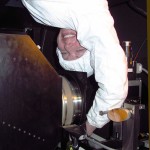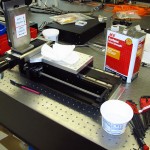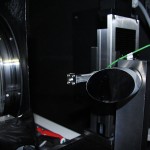It began, as all these things do, with a phone call from Liz…
“It’s stuck”
“What is stuck?”
“SFP won’t move in K2AO.”
“Do not try to move it any further, I am up tomorrow for SegEx, I will go look at it.”

SFP is different, it can crash into the rotator if it gets lost. There is no real way to fix this issue, it has to be this way. SFP stands for Simulator Fiber Positioner, an artificial star created with a optical fiber. Placing the tip of the fiber at the telescope focus creates a bright dot of light that we can use to align and calibrate the AO system. The three axis stage can move the fiber into the light path and accurately position it just where you need it for system tests. There is also a diagonal mirror used to inject light from the telescope simulator and the spectral calibration source mounted atop the simulator.
The stage is three linear stages bolted together, each driven by a servo motor and a worm gear. The stages are under the control of OBS, the Optical Bench Subsystem. If it has anything to do with OBS, it is my problem to fix.
What I find the next day is somewhat perplexing… I expect to find the fiber chuck jammed into the protective plate in front of the rotator. It is not. It is out and away, apparently ready to move. I send a command to move using the AO laptop, it does not move, even with the motor at full power. Well #$@&*!
The real issue with SFP is that the stage is nearly inaccessible. It is placed at the back of the optical bench, right where the light comes in from the telescope. Reaching past the telescope simulator and calibration source I can just reach SFP. It is not a comfortable position and I fear bumping something that will take hours to re-align.
Taking the cover off the linear stage I attempt to turn the worm gear with my hand. This is when I find the problem…
The grease.
Grease should be… Well? Greasy.
It is not. Rather what I find is more the consistency of dried honey.
This is bad.
Two possibilities occur to me, knowledge gained through years of experience. Perhaps the grease has just dried out, the light volatile components lost to many years in the very dry air of the summit. Perhaps two incompatible greases have been used on the worm gear, reacting with each other to create a congealed mess. Both I have seen before.

I anxiously read the night logs each morning as we go through the five night run, waiting for the stage to fail again. It does not, it keeps moving.
The breather allows me time to schedule a real service mission. I have to arrange taking AO down for an entire week, not something done on the spur of the moment. I write a brief plan and schedule, phone calls and emails bounce as everyone gives their input. The following week is the best time, the largest gap in the AO schedule for the next six months.
I will need help to get the stage out, a quick message and I have a surplus of volunteers. Rachael, Tatayana, Pete, Joe, Eric… There is really only room for two people at a time, and that is tight!
To get at the SFP we will need to take one side off the bench, several panels and a post, and remove the telescope simulator. Only then can we reach the SFP properly. It is the telescope simulator that is trouble. This large optical assembly is constructed with inch thick steel plates, weighing in at something like 150 pounds. Pete and I can just lift it out of the bench, we then squeeze around NIRC2 with it. Setting it in the middle of the open floor we both gasp for breath in the thin air.
Rachael and I carefully set blocks to allow the repositioning of the SFP stage before we remove it. It must go back into exactly the same place, the steel blocks bolted to the bench will allow us to slide the stage into the correct position. With the preparations made it is a simple matter to release the dogs and slide the stage out of the AO bench.

One perplexing issue is the choice of grease for the stage. I wish to avoid using the original grease, it may be the problem. I sit back, stare at the freshly cleaned worm gear on the bench in front of me, and worry. The wrong choice here is not to be contemplated.
A solution presents in a conversation with one of our instrument techs… What do you use? A tube of red grease is offered. A lithium soap based lubricant the instrument guys have been using for years. They like it, or rather it has not been a problem for them. I download the manufacturer’s product data and start reading. I will use the Mobilith SHC-220 Gary suggested.
Another day is spent carefully spreading grease, and running each worm gear from end to end of the travel. One by one the tray of screws dwindles, carefully reassembling the entire unit. The red grease seems to work well, a nice consistency for the worms and linear bearings.

It takes one further day of work, an entire week spent on the task, to reassemble the AO bench, reinstalling the SFP and everything else we removed to get access to it. There is a point at which the cables are reconnected and there is no choice but to press the mouse button. The stage moves under computer control again, properly initializing and finding the home position. Further moves add to my relief. I put the SFP through a series of commanded moves, repeating the tests over and over. Running the stage back and forth further spreads the new grease and soothes my worries.
Does it work? All of our testing says yes. I await final word from our support astronomers who are checking and calibrating the system. I have some worries about the alignment. Did everything go back into the right place. So far no word, which is good news to me. The real test will come in a few more days, when the AO system is back on-sky. I will again be reading the night logs.

